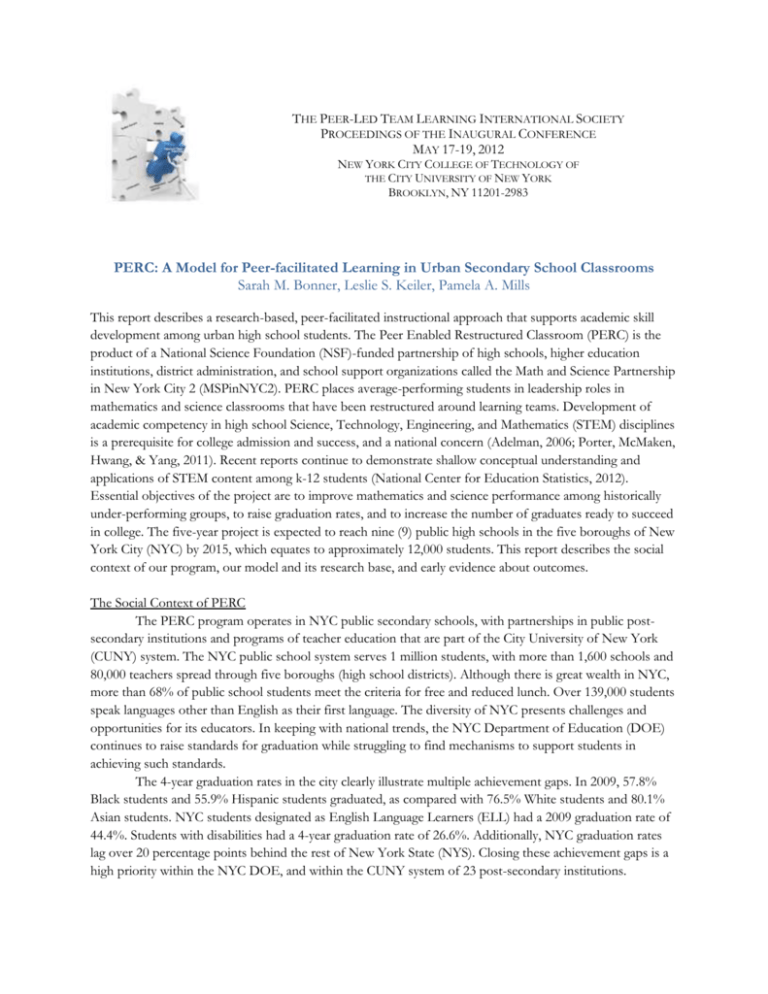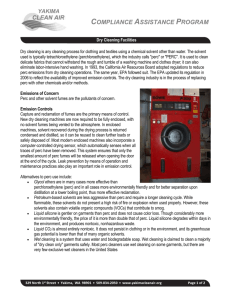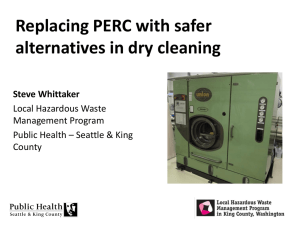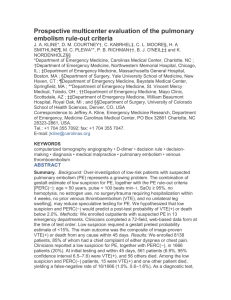Bonner-2012 - Peer-Led Team Learning International Society
advertisement

THE PEER-LED TEAM LEARNING INTERNATIONAL SOCIETY PROCEEDINGS OF THE INAUGURAL CONFERENCE MAY 17-19, 2012 NEW YORK CITY COLLEGE OF TECHNOLOGY OF THE CITY UNIVERSITY OF NEW YORK BROOKLYN, NY 11201-2983 PERC: A Model for Peer-facilitated Learning in Urban Secondary School Classrooms Sarah M. Bonner, Leslie S. Keiler, Pamela A. Mills This report describes a research-based, peer-facilitated instructional approach that supports academic skill development among urban high school students. The Peer Enabled Restructured Classroom (PERC) is the product of a National Science Foundation (NSF)-funded partnership of high schools, higher education institutions, district administration, and school support organizations called the Math and Science Partnership in New York City 2 (MSPinNYC2). PERC places average-performing students in leadership roles in mathematics and science classrooms that have been restructured around learning teams. Development of academic competency in high school Science, Technology, Engineering, and Mathematics (STEM) disciplines is a prerequisite for college admission and success, and a national concern (Adelman, 2006; Porter, McMaken, Hwang, & Yang, 2011). Recent reports continue to demonstrate shallow conceptual understanding and applications of STEM content among k-12 students (National Center for Education Statistics, 2012). Essential objectives of the project are to improve mathematics and science performance among historically under-performing groups, to raise graduation rates, and to increase the number of graduates ready to succeed in college. The five-year project is expected to reach nine (9) public high schools in the five boroughs of New York City (NYC) by 2015, which equates to approximately 12,000 students. This report describes the social context of our program, our model and its research base, and early evidence about outcomes. The Social Context of PERC The PERC program operates in NYC public secondary schools, with partnerships in public postsecondary institutions and programs of teacher education that are part of the City University of New York (CUNY) system. The NYC public school system serves 1 million students, with more than 1,600 schools and 80,000 teachers spread through five boroughs (high school districts). Although there is great wealth in NYC, more than 68% of public school students meet the criteria for free and reduced lunch. Over 139,000 students speak languages other than English as their first language. The diversity of NYC presents challenges and opportunities for its educators. In keeping with national trends, the NYC Department of Education (DOE) continues to raise standards for graduation while struggling to find mechanisms to support students in achieving such standards. The 4-year graduation rates in the city clearly illustrate multiple achievement gaps. In 2009, 57.8% Black students and 55.9% Hispanic students graduated, as compared with 76.5% White students and 80.1% Asian students. NYC students designated as English Language Learners (ELL) had a 2009 graduation rate of 44.4%. Students with disabilities had a 4-year graduation rate of 26.6%. Additionally, NYC graduation rates lag over 20 percentage points behind the rest of New York State (NYS). Closing these achievement gaps is a high priority within the NYC DOE, and within the CUNY system of 23 post-secondary institutions. How It Works: PERC and Its Research Base The PERC Student. The PERC experience for a student in a typical school in our program begins in 9th grade in two courses: a biology course called Living Environment (LE) and a first-year algebra course called Integrated Algebra (IA). PERC uses peer-assisted team learning techniques similar to small-group cooperative learning practices (Ginsburg-Block, Rohrbeck, & Fantuzzo, 2006). It differs from some cooperative learning practices in the presence of slightly older, trained team leaders or group tutors, who guide groups on a daily basis within the class period (i.e., as opposed to after-school). Tutoring has been shown to provide widespread benefits, including improvements in academic performance, behavior, attendance, social skills, and self-confidence (Ginsburg-Block et al., 2006; McMaster, Fuchs and Fuchs, 2006; Morrison, 2004; Robinson, Schofield, & Steers Wentzell, 2005). The PERC classroom is truly student-centered. Outside observers commonly remark, “Every student is talking about math/science!” The Teaching Assistant Scholar. In the PERC model, the older, trained team leaders or group tutors are called Teaching Assistant Scholars (TA Scholars). In each PERC classroom there are 7-8 TA Scholars – high school students who passed the course and associated Regents exam the prior year. Each TA Scholar is therefore typically one grade ahead of students on the learning teams. The TA Scholar is recruited from the pool of average-achieving (not honors) students, based primarily on 9th grade teacher recommendations that prioritize attendance and attitude over academic performance. In each IA or LE class, 30 minutes of every class, every day, is spent in group work facilitated by the TA Scholars. The TA Scholars provide guidance to their student groups as they work on an activity or set of problems designed by the teacher. In the groups, the TA Scholars ask questions, scaffold thinking, offer encouragement, and assess performance. With English Language Learners (ELLs), TA Scholars make content comprehensible by using research based literacy strategies and strategic use of the native language. The TA Scholar-student interactions are supervised and assessed by the teacher who uses the information to plan subsequent classes, differentiating instructional plans based upon student performance. The training of the TA Scholars is intended to reinforce and enrich conceptual understandings in the content areas for the TA Scholars, and address 21st century skills such as goal-setting, monitoring, and questioning (National Research Council, 2010; National Science Teachers Association, 2011). Each TA Scholar participates daily in a special class led by the PERC classroom teacher. This class supports the dual role of the Teaching Assistant Scholar- 1) being a peer team leader in the PERC class and 2) becoming college-ready in their own right. In this class, TA Scholars practice teaching and tutoring techniques, review PERC upcoming classroom lessons, give feedback to the teacher about the PERC students, and reflect upon and extend prior learning. TA Scholars are trained in formative assessment techniques, which have been shown in multiple reviews and meta-analyses to contribute significantly to improving student achievement and closing achievement gaps (Black & Wiliam, 1998; Kingston & Nash, 2011). Current program emphases of training for TA Scholars that are aligned with research on formative assessment include analysis of learning expectations (McMillan, 2003), use of questioning and informal assessment methods (Ruiz-Primo & Furtak, 2007), and providing feedback to students (Brookhart, 2001). The training and tutoring experiences of TA Scholars are designed to maximize their academic college-readiness and motivation. Research has suggested that tutoring changes outcomes for peer leaders as well as for tutored students (Ginsburg-Block et al., 2006; Roscoe & Chi, 2007; Topping, 2005). In a literature review on peer tutoring in mathematics, 87% of reviewed studies reported academic improvements among tutors (Robinson, et al., 2005). Robinson et al. (2005) reported several studies that found an increase in selfconcept among peer tutors. The PERC Teacher. The PERC program’s teacher professional development model is teacher-need driven and embedded in the daily work of the participating teachers. Teachers enter the program during summer school, developing skills through co-teaching practice with an experienced teacher and experienced TA Scholars. Academic year mentoring includes weekly meetings with professional development staff and support from experienced teachers. Teachers participate as novices for the first two years and then become lead teachers once they have mastered teaching both the PERC and TAS classes. Like the TA Scholars, potential PERC teachers are identified primarily based upon their beliefs that all students can learn and that students can learn from each other, rather than any particular prior skill set or experiences. In contrast to traditional top-down, isolated-experience approaches to professional development (Gusky, 2000), the PERC program’s teacher professional development model is teacher-need driven and embedded in the daily work of the participating teachers, fulfilling Gusky’s (2009) concept of “just-in-time” professional development. As teachers restructure their classrooms around PERC, they identify their own learning needs to be effective PERC teachers, providing their own motivation for professional development. Thus the teachers become critical stakeholders in the professional development process. Research on early implementation of the model by Keiler (2011) indicated that effective teachers who used PERC developed, among other things, an identity as a teacher that centered on planning effective learning experiences, assessing student understanding, and managing a team rather than directly explaining content. In interviews and focus groups, teachers have reported benefits including elimination of classroom management problems, increased student time on task, and deepening of cognitive demands. Evidence of Impacts Data are shown in Table 1 representing demographic profiles for five schools served between 2008-2010, which were pilot years for the PERC model. Due to the non-selective nature of participating high schools and the program policy of non-selective enrollment in PERC classes, these schools are fairly representative of the student body attending NYC non-selective public secondary schools, and of schools served in more recent years. Table 1: Student Characteristics at Participating Schools, 2008-2010 School A B C D E Enrollme nt 2372 522 274 1507 1491 Grad. Rate 66% 49% 81% 49% 75% Poverty ESL 41% 79% 83% 64% 49% 6% 12% 70% 22% 7% African American 55% 36% 8% 29% 19% Hispanic Asian White 41% 59% 73% 58% 51% 2% 3% 6% 8% 17% 1% 1% 12% 3% 12% Results indicating impacts on student achievement are drawn from archival records (official test scores), and include only data from years 2008 to 2010. Data were aggregated at the classroom unit level, resulting in small cell sizes; thus only descriptive statistics are reported. Development of student-level comparison groups for more powerful analyses is underway. Using aggregated data, the impact of PERC on student performance was systematically studied in five schools with 16 teachers in IA and LE content areas from 2008 to 2010 as part of pilot field trials of the PERC model. Sixteen fully certified mathematics and science PERC teachers implemented the PERC model and participated in data collection. The pilot evidence suggests that participation in PERC is associated with positive outcomes for the students. Using data from different comparison groups, including same school historical data, same teacher historical data, same school data in classrooms not using the PERC model, and city-wide data, we compared PERC student outcomes to quasi-equivalent non-PERC (traditional instruction) counterparts in multiple schools over multiple teachers. In classes in which students were taking the course for the first time (46 classes), the student passing rates on the Regents exams in PERC classes consistently exceeded passing rates in comparable, non-PERC classes (Table 2). Discrepant results such as those from a single large Manhattan school (see Table 2, School E, teacher #15) are studied carefully and are often used for program planning and improvement. In the case of School E, Teacher #15, the comparison is deceptive, because in the comparison group low-performing students were discouraged from attempting the exam, while in the PERC LE classroom, 100% of students were encouraged to attempt the exam. When one compares for Teacher #15 the number passing out of total enrolled LE students to the number passing out of total enrolled in the relevant comparison class, PERC outperformed the comparison by 13 percentage points. Table 2. PERC Passing Rates with Comparison Groups PERC Group Teacher/School Course #1/ School A—Large IA Bronx #2 IA #3 IA #4 IA #5/School B—Small Bronx LE #6/School C—Small ELL LE Bronx #7 IA #8 IA #9 IA #10/School D– Large IA Manhattan #11 IA #12 IA #13 LE #14 LE #15/School E– Large LE Manhattan #16 IA a. N 89 Comparison Group % passing a. N % passing a. 64.0% 199 42.7% 82 116 93 30 88 67.1% 53.0% 52.0% 96.7% 69.3% 199 23 23 68 69 42.7% 30.0% 30.0% 76.5% 42.0% 18 40 44 58 88.9% 47.5% 47.7% 46.6% 43 14 72 193 76.7% 50.0% 38.9% 19.7% 37 66 71 40 47 40.5% 30.3% 66.2% 77.5% 82.0% 193 193 212 212 37 19.7% 19.7% 49.0% 49.0% 88.1% 45 82.0% 214 68.0% Passing defined on IA and LE Regents exams as at or above scaled score of 65. PERC has also been implemented in summer school for students with histories of failure. In the 2011 summer school, PERC students passed LE examinations at a rate of 83%, compared to a city-wide passing rate of 29% among students who took the same exam at the end of the summer, who were either enrolled in non-PERC summer LE courses or took the exam without taking a course. Summer PERC IA passing rates were even better, with a 94% passing rate for PERC IA students, compared to a city-wide 29% passing rate for non-PERC students who took the summer IA exam. The PERC experience has also positively impacted the achievement of the TA Scholars. The TA Scholars are drawn from the cohort of students who succeeded in the LE or IA courses but whose Regents scores are not high enough for entry into the CUNY four-year colleges. This cohort of students is likely to graduate high school, enter community college, and place into remedial mathematics courses (Michalowski, 2007). From 2009 to 2011, TA Scholars were encouraged to retake the Regents exams after their year in the PERC classroom. Scores improved on average by 8 points to over 80, a level acceptable for admission to a CUNY senior college (over 75). The focus on the TA Scholar and the potential to create a new cadre of students truly prepared for STEM courses in college is a primary goal of current efforts under the new funding of the MSPinNYC2. Discussion This report has described how the PERC model of peer-facilitation of instruction and teacher support for peer-to-peer experiences helps students improve competencies in mathematics and science, and helps teachers address the demands of urban education. PERC places students at the center of the STEM instructional experience, both as learners and facilitators of learning. In 9th grade PERC mathematics and science classes, the majority of the daily learning experience occurs in small groups led by TA Scholars. Implementation of the PERC model radically alters role of teachers in the classroom, shifting their primary task from dispensing information to planning effective learning experiences, assessing student understanding, and preparing the TA Scholars to meet the learning needs of their students. It creates a coherent classroom community that focuses on academic performance and student self-efficacy, changing the definition of success from barely passing to mastery of STEM content. PERC is a promising approach to improving achievement in mathematics and the sciences among historically under-performing groups in urban nonselective high schools. The intervention has two important implications: 1) achievement benefits at two levels are evidenced, for students in the 9th grade level learning teams, and for 10th grade TA Scholar team-leaders; 2) sustainability at low cost to schools, because PERC uses students as teaching assistants (assets) and requires financial input only for professional development for teachers. The evolution of PERC began in 2009 when we started to create and evaluate the model based upon what was learned in the preliminary years of a previous NSF partnership grant. Under new funding from the NSF for MSPinNYC2, our program is building the evidence-base about the effectiveness of the PERC model, and developing new innovations to support challenging goals related to success at the college level. We recognize there are organizational and institutional challenges to the success, scale-up, and sustainability of school-based innovations. We are a complex partnership of students, teachers, public secondary schools, school support organizations, and institutions of higher education. We are dedicated to working to address the legitimate needs of all our partners, ranging from developing school-based agreements about scheduling students in ways that facilitate their success, to creating supports that address ways that peer and school cultures can promote a climate of achievement, to collaborating with NYC DOE and CUNY to share data and learn from evidence. More information and videos about our model can be obtained from our website: http://www.mspinnyc.org. References Adelman, C. (2006). The toolbox revisited: Paths to degree completion from high school through college. Washington, DC: U.S. Department of Education. Black, P., & Wiliam, D. (1998). Assessment and classroom learning. Assessment in Education: Principles, Policy & Practice, 5(1), 7–75. Brookhart, S. M. (2001). Successful students' formative and summative uses of assessment information. Assessment in Education: Principles, Policy & Practice, 8(2), 153-169. Conley, D. T. (2008). Rethinking college readiness. New Directions for Higher Education, 144, 3-13. Ginsburg-Block, M. D., Rohrbeck, C. A., & Fantuzzo, J. W. (2006). A meta-analytic review of social, selfconcept, and behavioral outcomes of peer-assisted learning. Journal of Educational Psychology, 98(4), 732-749. Guskey, T. R. (2000). Evaluating professional development. Thousand Oaks, CA: Corwin Press. Guskey, T. R. (2009). Closing the knowledge gap on effective professional development. Educational Horizons, 87(4), 224-233. Keiler, L. (2011). Am I still the teacher?: The teacher’s role in a peer-mediated learning environment. Proceedings of the Hawaii International Conference on Education. Kingston, N., & Nash, B. (2011). Formative assessment: A meta-analysis and a call for research. Educational Measurement: Issues and Practice, 30(4), 28-37. McMaster, K. L., Fuchs, D., & Fuchs, L. S. (2006). Research on peer-assisted learning strategies: The promise and limitations of peer-mediated instruction. Reading & Writing Quarterly, 22(1), 5-25. McMillan, J.H. (2003). Understanding and improving teachers’ classroom assessment decision making: Implications for theory and practice. Educational Measurement: Issues and Practice, 22(4), 34-43. Michalowski, S. (2007). Positive Effects Associated with College Now Participation. Report to the City University of New York. Retrieved from http://www.cuny.edu/academics/k-to12/databook/library/cnparticipationpositive917.pdf. Morrison, M. (2004). Risk and responsibility: The potential of peer teaching to address negative leadership. Improving Schools, 7(3), 217-226. National Center for Education Statistics (2012). The Nation’s Report Card: Science in Action: Hands-On and Interactive Computer Tasks From the 2009 Science Assessment (NCES 2012–468). Institute of Education Sciences, U.S. Department of Education, Washington, D.C. National Research Council (2010). Exploring the Intersection of Science Education and 21st Century Skills: A Workshop Summary. Washington, DC: The National Academies Press. National Science Teachers Association (2011). Quality Science Education and 21st-Century Skills. Retrieved from http://www.nsta.org/about/positions/21stcentury.aspx Porter, A., McMaken, J., Hwang, J., & Yang, R. (2011). Common core standards. Educational Researcher, 40(3), 103-116. Robinson, D. R., Schofield, J. W., & Steers-Wentzell, K. L. (2005). Peer and cross-age tutoring in math: Outcomes and their design implications. Educational Psychology Review, 17(4), 327-362. Roscoe, R. D., & Chi, M. T. H. (2008). Tutor learning: The role of explaining and responding to questions. Instructional Science: An International Journal of the Learning Sciences, 36(4), 321-350. Ruiz-Primo, M. A., & Furtak, E. M. (2007). Exploring teachers’ informal formative assessment practices and students’ understanding in the context of scientific inquiry. Journal of Research in Science Teaching, 44(1), 57– 84. Topping, K. J. (2005). Trends in peer learning. Educational Psychology, 25(6), 631-645. Cite this paper as: Bonner, S.M., Keiler, L.S., Mills, P.A. (2013). PERC: A model for peer-facilitated learning in urban secondary school classrooms. Conference Proceedings of the Peer-Led Team Learning International Society, May 17-19, 2012, New York City College of Technology of the City University of New York, www.pltlis.org; ISSN 2329-2113.





